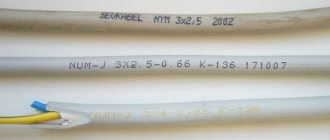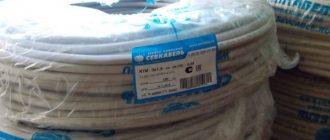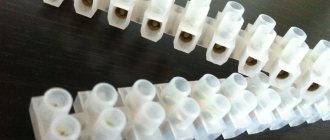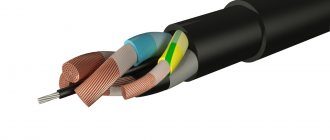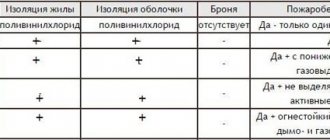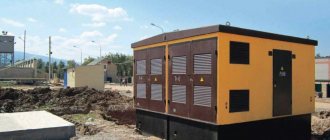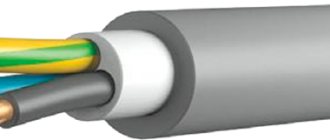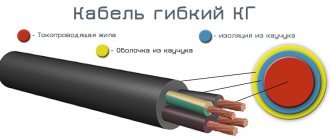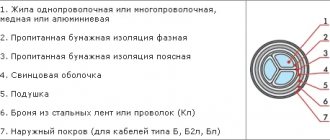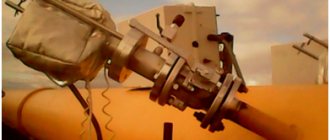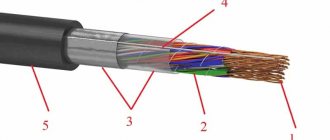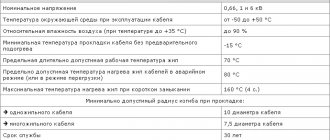How is it deciphered?
The wire is marked not only with letter values, but also with numbers. You can decipher MKESH as:
- M - the cable belongs to the installation group;
- K is a subtype of conductor. This means that the insulation contains a nylon layer;
- E - the wire is shielded;
- Ш - external insulation is made of polyvinyl chloride.
What the product looks like.
The cable can also be found under the name MKSh. This indicates that the product does not have a shielded sheath, due to which the price of the wire will be lower. There are varieties of the product MKEShv, MKEShVng, MKEShVng-LS, you can read about them in more detail on the Internet. Below is a detailed description of the technical parameters.
Wire MKESh technical characteristics and design
Universal cable MKESHV, MKEKSHV
MKEKSHV (ng, ng-LS) (armored) and MKESHV (ng, ng-LS) (without armor) TU 3581-006-76960731-2006 – Universal cable (installation, control, communication) for industrial data networks
MKESHV ng(A)-LS 4x2x1.0
Cables of the MKEKShV, MKEKShVng, MKEKShVng-LS and MKEShV, MKEShVng, MKEShVng-LS brands are designed according to special requirements for the formation of information field buses, connection of sensors with a digital frequency-modulated signal, a 4-20 mA signal, via the HART or RS 485 interface. Cables They are twisted pairs of wires with color markings in a common shield or with pairwise shielding, armored (wire) armor - only for MKEKSHV (ng, ng-LS). Designed for stationary installation indoors and outdoors in cable ducts and in open ground, including in explosive zones of class IIВТ4. Rated alternating voltage up to 500V, with a frequency up to 400Hz, direct voltage up to 750V. Operation at ambient temperatures from −50° to +50°C. It is possible to use cables in all macroclimatic regions including the tropics.
| Conductor | — copper stranded, tinned, 3 classes of flexibility according to GOST 22483-77 |
| Core insulation | — PVC plastic with color marking |
| Screen | — paired (in the form of a braid of tinned copper wires) or common (in the form of a braid of copper (tinned upon request) wires) |
| Carapace armor | - Armor armor (MKEKShV (ng, ng-LS)) - made of galvanized steel wire in the form of a continuous layer, which provides increased flexibility compared to cables in tape armor (bending radius - 10 outer diameters) |
| Outer shell | — PVC |
| Electrical parameters * | Parameter value for sectioning. | ||
| 0.5 mm2 | 0.75 mm2 | 1.0 m2 | |
| Ohmic resistance of conductors at direct current, (Ohm/km) | ≤ 40,7 | ≤ 26,0 | ≤ 22,3 |
| Operating capacitance of a pair, (nF/km) at a frequency of 1 kHz at a frequency of 256 kHz | 108 | 120 | 130 104 |
| Attenuation coefficient (dB/km) At 4 kHz At 0.1 MHz At 1 MHz | 8,10 35,0 | 8,00 34,0 | 1,66 6,70 33,0 |
| Characteristic impedance (Ohm/km) in the range 0.1-100 MHz | 78-83 | 71-75 | 55-68 |
*According to these parameters, the cable corresponds to foreign analogues
| Cable MKEKSHV, MKEKShVng, MKEKShVng-LS | ||||||||||
| External diameter, (mm) / Weight 1 km, (kg) *Volume of combustible materials in 1 m of cable, (l) | ||||||||||
| Section, (mm2) | Number of twisted pairs | |||||||||
| 2×2 | 4×2 | 5×2 | 7×2 | 10×2 | ||||||
| OE | PE | OE | PE | OE | PE | OE | PE | OE | PE | |
| 0,5 | 13,8/230 0,104 | 15,1/261 0,115 | 14,8/277 0,123 | 16,5/348 0,140 | 16,3/331 0,142 | 17,5/399 0,156 | 17,3/386 0,161 | 19,0/500 0,190 | 20,8/520 0,220 | 22,7/664 0,245 |
| 0,75 | 14,5/257 0,111 | 15,6/287 0,123 | 16,1/325 0,133 | 17,5/376 0,151 | 17,1/381 0,153 | 19,0/466 0,181 | 18,7/470 0,189 | 20,0/562 0,206 | 22,1/610 0,241 | 24,4/778 0,284 |
| 1,0 | 15,1/283 0,119 | 16,6/310 0,131 | 16,3/364 0,143 | 18,8/419 0,162 | 18,4/447 0,178 | 20,0/518 0,194 | 19,7/530 0,204 | 21,5/629 0,222 | 23,3/699 0,260 | 25,9/939 0,318 |
| 1,2 | 17,6/362 0,155 | 18,0/393 0,168 | 19,2/481 0,193 | 19,5/550 0,210 | 20,7/547 0,215 | 21,5/640 0,237 | 22,0/653 0,248 | 22,9/786 0,272 | 25,1/802 0,289 | 28,0/1061 0,362 |
| 1,5 | 17,9/381 0,162 | 18,3/409 0,173 | 19,7/513 0,202 | 20,0/578 0,218 | 21,1/587 0,225 | 21,9/678 0,247 | 22,9/729 0,276 | 23,8/836 0,287 | 27,0/941 0,328 | 29,5/1193 0,388 |
| Cable MKEShV, MKEShVng, MKEShVng-LS | |||||||||||||
| External diameter, (mm) / Weight 1 km, (kg) *Volume of combustible materials in 1 m of cable, (l) | |||||||||||||
| Section, (mm2) | Number of twisted pairs | ||||||||||||
| 1×2 | 2×2 | 4×2 | 5×2 | 7×2 | 10×2 | 14×2 | |||||||
| OE | PE | OE | PE | OE | PE | OE | PE | OE | PE | OE | PE | ||
| 0,5 | 8,2/66 0,030 | 11,2/132 0,048 | 12,2/149 0,052 | 12,2/179 0,062 | 13,7/222 0,070 | 13,6/213 0,074 | 14,8/262 0,080 | 14,6/257 0,089 | 15,9/331 0,106 | 17,7/346 0,130 | 19,6/456 0,142 | 19,0/420 0,157 | 21,1/588 0,171 |
| 0,75 | 8,6/75 0,033 | 11,8/155 0,052 | 12,9/167 0,057 | 12,9/210 0,069 | 14,5/254 0,077 | 14,4/252 0,082 | 15,6/301 0,098 | 15,6/314 0,109 | 16,9/383 0,117 | 19,0/422 0,145 | 20,9/530 0,157 | 20,4/519 0,175 | 22,5/687 0,190 |
| 1,0 | 9,0/84 0,035 | 12,4/173 0,057 | 13,5/187 0,061 | 13,6/245 0,075 | 15,3/288 0,093 | 15,3/295 0,099 | 16,6/343 0,106 | 16,6/365 0,119 | 17,9/439 0,127 | 20,2/496 0,159 | 22,5/609 0,171 | 21,8/618 0,192 | 24,0/794 0,208 |
| 1,2 | 10,4/117 0,045 | 14,5/219 0,072 | 15,0/228 0,082 | 16,2/319 0,110 | 17,0/360 0,113 | 17,5/372 0,126 | 18,5/430 0,130 | 18,8/464 0,152 | 19,9/557 0,158 | 23,4/637 0,205 | 25,4/761 0,240 | 24,8/819 0,249 | 27,4/1004 0,288 |
| 1,5 | 10,6/124 0,047 | 14,8/233 0,076 | 15,3/242 0,086 | 16,7/345 0,116 | 17,3/386 0,119 | 18,1/405 0,134 | 18,9/462 0,138 | 19,5/510 0,162 | 20,4/600 0,168 | 24,1/723 0,220 | 26,0/822 0,254 | 25,5/902 0,288 | 28,1/1087 0,311 |
Technical specifications
Main product parameters:
- The use of the wire is permitted at constant and alternating mains voltage. The optimal alternating voltage is 0.5 kV at a frequency of no more than 400 hertz;
- operating temperature ranges from −50 to 70 degrees. The gasket temperature should not be lower than −15. Otherwise, the insulating layer may be damaged;
- the critical temperature at which the wire can function is 130 degrees;
- the bend radius is equal to four diameters;
- humidity indoors or outdoors should not be higher than 95%;
- the wire is allowed to be laid together with other types of products in one bundle;
Cable MKESH 7×0.35
- the construction length of the wire is 30 meters and above;
- MKESH - cable resistant to mechanical loads;
- The service life of the wire is 15 years;
- minimum 2 year warranty.
All parameters can be found in the product specification that comes with the purchase of the cable.
Main design elements of MKESH cable
Section of the MKESh cable showing all elements
Features of each element
- Individual conductive wires are multi-strand twisted from thin tinned copper wires. The number of current-carrying conductors in the cable depends on the brand of cable 2…..14. The composition of the alloy from which the cores are made is dominated by copper; additives provide high conductivity. Regardless of the cross-section of the conductors, their resistance is no more than 0.1 MOhm/km;
- All wires are covered with a fire-resistant insulating sheath of its own color, for the manufacture of which PVC plastic is used;
- The shielding shell is made in the form of a woven mesh of the finest copper wires. This design very reliably protects the main conductors from possible electromagnetic interference, this eliminates the possibility of distortion of the transmitted signals. This measure is very important, especially in computer control circuits and telephone lines.
- The outer shell is made of moisture-resistant types of PVC; after laying the cable at the facilities, a waterproofing termination is required. This measure prevents the penetration of liquid between the insulating layers of the cable.
Wire design
MKESH consists of stranded copper wire. The number of cores can vary from four to fifteen. The veins are twisted together. The outer insulation layer is made of polyvinyl chloride. It is flame resistant. A special synthetic shell is placed on the top of the core, and a protective screen is placed on it.
You might be interested in: Features of heat shrink tube
Note! The shielded layer consists of small copper wires, which have a density coefficient of 62%. The main purpose of the screen is to protect the product from a variety of electromagnetic noise.
Shielded conductors
Thanks to the shielded layer, the wire functions stably and conducts electric current correctly. Below we describe where MKES is most often used and how to choose it correctly.
MKESH, MKEKShv, MKEKShvng-LS
Please call for price. MKESH shielded installation cable
Scope of application
The MKES installation cable, like the traditional MKSH wire, is used for fixed installation of any electrical equipment, devices and units in domestic and industrial conditions.
However, the use of such a cable has a number of limitations related to the characteristics of the working electrical network. Thus, the normal alternating voltage for such cables should not exceed 500V, while the direct voltage of the network may not be higher than 750V. The rated mains voltage for MKESh wires should not be higher than 400Hz.
offers a large selection of MKESH cables and their modifications, such as MKEKShv and MKEKShvng-LS.
Features of armored installation cables
The MKEKShv cable belongs to the group of reliable armored installation wires that are used for data transmission in any industrial networks. Such wires can be laid both indoors and outdoors, into sewer channels and directly into the ground.
Like standard MKESh wires, such cable and wire products are a multi-core design based on stranded copper cores twisted into twisted pairs.
The operating temperature range of armored installation cables ranges from -50 to + 50 degrees. The average service life is 15 years.
MKEKShvng-LS also belongs to the group of armored cables. However, such a wire has additional improved characteristics. It does not spread combustion, and in the event of a fire it does not emit harmful smoke or toxic gas.
It is also worth noting that this cable is designed specifically for connecting sensors with a digital FM signal.
Advantages of shielded cables
When choosing a microcash cable, price does not play a special role, because regular consumers of shielded wires understand their real value, which lies in the following advantages of such cable and wire products:
Firstly, shielded cables are not subject to external electromagnetic interference, which ensures more stable operation of the electrical network.
Secondly, they have better mechanical characteristics and are more durable.
Third, a shielded cable will prevent unauthorized access to your database.
And finally, the attenuation of such wires occurs much less frequently than with unshielded cables. This means they can provide more efficient heat transfer.
MKESh cable design:
|
MKESH cable with tinned copper stranded conductors with PVC insulation, with a screen made of copper wires, in a PVC sheath.
Technical and operational characteristics of the MKESH cable:
| Rated alternating voltage up to 400 Hz | up to 500 V |
| Rated DC Voltage | up to 750 V |
| Ambient temperature during operation | from -50°С to +70°С |
| Relative air humidity (at temperatures up to +35°C) | up to 98% |
| Minimum gasket temperature without preheating | -15°С |
| Minimum bending radius during installation | 5 cable diameters |
| Construction length | not less than 25 m |
| Life time | 15 years |
MKESh cable configurations
| Name | D, mm | Specific gravity, kg/m |
| Cable MKESH 2x0.35 | 6,6 | 0,051 |
| Cable MKESH 2x0.5 | 6,8 | 0,055 |
| Cable MKESH 2x0.75 | 7,3 | 0,066 |
| Cable MKESH 3x0.35 | 6,9 | 0,059 |
| Cable MKESH 3x0.5 | 7,1 | 0,067 |
| Cable MKESH 5x0.35 | 7,9 | 0,081 |
| Cable MKESH 5x0.5 | 8,2 | 0,090 |
| Cable MKESH 5x0.75 | 8,7 | 0,109 |
| Cable MKESH 7x0.35 | 8,4 | 0,097 |
| Cable MKESH 7x0.5 | 8,7 | 0,110 |
| Cable MKESH 7x0.75 | 9,4 | 0,136 |
| Cable MKESH 10x0.35 | 10,6 | 0,142 |
| Cable MKESH 10x0.5 | 11,0 | 0,160 |
| Cable MKESH 10x0.75 | 11,9 | 0,196 |
| Cable MKESH 14x0.35 | 11,3 | 0,173 |
| Cable MKESH 14x0.5 | 11,8 | 0,197 |
| Cable MKESH 14x0.75 | 12,8 | 0,248 |
Scope of application
MKESh cable is mainly used in such industries as:
- video surveillance and alarm;
- electronic systems switching units;
- in measuring instruments;
- in telephony;
- for connecting a variety of sensors.
In terms of use, MKESh cable is one of the most popular and is widely used in various fields. It is used to make permanent connections of electrical equipment in both domestic and industrial premises. Due to its design, this wire cannot always be used. The limitation is the AC current limits.
External laying process
Main purpose of the MKESh cable
The cable is successfully used during commissioning of electronic equipment for switching connections in circuits for connecting instrumentation. The cable is especially in demand in secondary circuits (low-current) of automatic control systems, where computer equipment is connected to control the equipment:
- For remote control of transmitting and receiving equipment at radio and television centers;
- In systems with telemechanical equipment;
- In security alarm and video surveillance systems at other facilities where telemetric monitoring of parameters and control of individual elements in a complex of electronic equipment is required.
The abbreviation MKESH is deciphered by specialists as a listing of the characteristics of the purpose and materials from which the cable is made:
- M – installation;
- K – nylon insulation;
- E – shielded;
- Ш – with elements of polyamide silk.
During the installation of the listed objects, the laid MKESH brand cables provide electrical connections between individual equipment devices. The connection is made through terminal blocks on communication cross-connections by soldering wires to contacts. Sometimes special modifications of the MKESh cable are used, adapted for FM sensors in circuits where digital signals are processed.
How to choose the right one
Like any cable product, MKESh must first be assessed visually. The packaging must be intact, the outer hose itself must be free of cracks and minor damage. It is recommended to ask the seller for a certificate for the product, which indicates the manufacturer, the warranty period for the cable and the date of manufacture.
When choosing, you must rely on the power of the devices that will be connected to the cable. Also, the power of the devices determines which wire cross-section to choose. The larger the cross-section, the higher the resistance in the network will be.
Labeling requirements
A high-quality cable from a reliable manufacturer must have the following data, which is located on a label attached to the coil or drum:
- brand trademark;
- full symbol of the cable, which indicates the number of cores and their nominal cross-section;
- length;
- date of manufacture;
- compliance with GOST.
MKESh wires are sold in coils. The standard winding length can be from 150 to 300 meters, depending on the size. The price of goods is usually indicated per 1 linear kilometer. The weight of the purchased batch can be found out using tables that display the weight of the MKESh cable depending on the number of cores and cross-section.
How to connect
The main advantage when laying the MKESh cable will be the ability to place it in cable ducts, pipes, trenches and other places with models for other purposes.
Cable shielding in the diagram
Cable shielding in the diagram The shielding layer does not allow electromagnetic interference from other wires to penetrate the conductors of the MKESH. This facilitates reliable transmission of control impulses, without noise, over long distances.
But to guarantee correct data transmission, it is necessary to correctly install the MKESH wire. Sometimes in distribution panels the ends of the cable cores were separated into cross-connect contacts.
Currently, a large number of crossover blocks are being made, where reliable fixation and electrical contact occur.
Consequence of short circuit
Consequence of a short circuit Through each end of the wire, a signal is transmitted to one or another device, so you need to connect everything according to the diagram. Otherwise, the equipment will not only fail, but also cause a short circuit. Connection rules:
- A plastic funnel is placed over the outer insulation of the wire, secured with a clamp, and all the wires are removed. The product is placed in a vertical position and epoxy resin must be placed in this funnel. After the wire dries, you can begin to solder it into cross-connects;
- if the ambient temperature is below −15, then the installation is not carried out, or the cable is preheated in the room;
- The wire can be laid under the soil in metal, asbestos or plastic corrugations, through the air or in the wall of a room.
You may be interested in this Wire marking designation
Advantages and disadvantages of wire
MKESh has the following advantages:
- reliable insulating coating that protects the cable from damage and short circuits;
- color coding of cores to facilitate installation;
- sufficient flexibility for laying;
- the presence of a protective screen that prevents the adverse effects of third-party equipment and electrical transmission lines.
The disadvantages of the cable are its narrow specialization of application and its inability to operate under heavy loads.
Common mistakes
Three main mistakes when laying cables:
- they forget about the number of veins. First of all, it is advisable to decide how many cores are needed to control network objects. Basically, a common cable and or screen with grounding is inserted onto each element. If, for example, there will be control with four objects, then five wires are needed
- Sometimes people don't know how to calculate cross-sectional area. For systems with low voltage, a cross section of up to 0.35 - 05 mm2 is suitable. For systems with 220 and above, 0.75 mm square is used;
- When laying, the shielding layer of the cable is not grounded and waterproofing is done at the ends.
Product marking
Classification and price
Several types of products are produced, the designation of which additionally indicates some letters:
- c – specialized cable for information buses and sensors;
- ng – fireproof wire;
- ng-LS – the above variety, providing reduced smoke and gas emissions,
The specified types of cable products are also produced in tropical versions and for use in cold climates:
- HL – cold-resistant version (operating temperature up to -60 °C),
- T – tropical version (resistance to mold fungi).
Also read: How to check the insulation of a transformer
The cable also varies in the number of conductive cores (from 2 to 14) and cross-section (ranging from 0.35 to 0.75 sq. mm. The price is also affected by the size of the purchased batch.
Transportation and storage rules
Like all cable products, MKESh must be stored in a dry and moderately humid room. At humidity levels above 90%, mold and mildew may form on the product, which will damage the insulating layer over time. All coils of wire must be stored on special cable drums (reels). There should be no rodents in the warehouse, as they can easily bite through the PVC shell. Storage under a canopy in the open air is allowed, but not more than 1000 hours in total and without direct sunlight.
Storage in reels
It is necessary to transport cable reels only in a special truck, having previously secured them. Loading and unloading is done using a small crane.
Note! Pulling out the coils with your own hands is dangerous.
If errors were made during storage, this will significantly shorten the life of the product.
Selecting a cable by cores and cross-section
The cross section of the cores is one of the most important criteria for choosing a product. To ensure the longest possible service life, it is necessary to choose a design with a large diameter copper core. To do this, you can use the following table:
| Number of cores and cross-section mm² | Diameter, mm | Weight, kg/km |
| 1x2x0.5 | 6.9 | 61.1 |
| 2x2x0.5 | 11.3 | 122 |
| 4x2x0.5 | 12.8 | 173.9 |
| 5x2x0.5 | 13.9 | 200.8 |
| 7x2x0.5 | 15.1 | 244 |
| 10x2x0.5 | 19.3 | 348.9 |
| 14x2x0.5 | 20.8 | 429.6 |
| 1x2x0.75 | 7.3 | 67.9 |
| 2x2x0.75 | 12.1 | 141 |
| 4x2x0.75 | 13.8 | 196.8 |
| 5x2x0.75 | 15 | 228.2 |
| 7x2x0.75 | 16.3 | 279.2 |
| 10x2x0.75 | 20.9 | 399.4 |
| 14x2x0.75 | 22.6 | 495.1 |
| 1x2x1.0 | 8.2 | 86.9 |
| 2x2x1.0 | 12.7 | 156.9 |
| 4x2x1.0 | 14.5 | 223.9 |
| 5x2x1.0 | 15.8 | 261.1 |
| 7x2x1.0 | 17.2 | 322.8 |
| 10x2x1.0 | 22.1 | 462.1 |
| 14x2x1.0 | 23.9 | 578.9 |
| 1x2x1.5 | 9.4 | 111.6 |
| 2x2x1.5 | 15.1 | 206.2 |
| 4x2x1.5 | 17.4 | 302.9 |
| 5x2x1.5 | 19.5 | 374.7 |
| 7x2x1.5 | 21.2 | 466.5 |
| 10x2x1.5 | 27.3 | 665.7 |
| 14x2x1.5 | 29.6 | 839.8 |
Manufacturers
Currently, there are many factories producing cable products. To avoid falling for a fake, it is recommended to choose the most proven ones. If a person is at a loss as to which factory to give preference to, you can visit the forum of electricians, who will tell you exactly which companies are more in demand. Below are a number of the best manufacturers.
How to transport it correctly
JSC "Belaruskabel"
The plant was founded in the Republic of Belarus back in the late 50s of the last century. We stock thermal radiation wires, heat resistant wires, RF wires, and many others. They deliver to Europe and Russia. They cooperate with well-known companies. There are always more than 30,000 types of products in stock. Delivery by air or rail to the most remote points of the country. The maximum product warranty is 5 years.
You might be interested in this All about SIP-4 wire
LLC "TD "Belkab"
The company was founded relatively recently, in 2009. During this time, they became one of the largest factories in Belarus and opened several branches in Russia. The manufacturer has all subtypes of MKESH cables in stock. The only drawback is that the company does not yet have its own website with an assortment. Therefore, to find out about product availability, you have to call or email.
JSC "Cable
One of the first cable companies that delivers throughout the country from any order amount. They work with well-known industrial and shipping companies. The company has many positive reviews and awards for its impeccable work. There are more than 35,000 thousand macro connectors products in stock.
Production process
KazElectroMash LLP
The plant was founded in the city of Semipalatinsk in the 1990s. Over the years of operation, the enterprise has laid more than one hundred kilometers of cable lines. There are more than 20,000 thousand types of macro connectors. A research center was built on the territory of the enterprise, so all products are of high quality. Individual approach to each order, even small ones. One of the fastest delivery of products to the client.
In conclusion, it should be noted that MKESh wire is excellent for telephone and security systems, CCTV cameras. More and more offices are switching to this cable model. When purchasing, it is advisable to read reviews about each factory or seek help from an experienced electrician.
Decoding the abbreviation
MKESH is a generalized marking of this series of cable products, where
- M - area of cable use, that is, installation work;
- K - the presence of an insulating layer made of nylon;
- E — presence of a protective screen;
- Ш - designation of the outer shell. In this case, a polyvinyl chloride hose.
In current catalogs and directories of cable products, generalized markings are not used; digital designations must be indicated to the right of it, for example, MKESH 14×0.75. The number 14 in this case indicates the number of cores, and 0.75 indicates the cross-section of the copper wire used when twisting it.
Mounting conductor MKESH
The scope of application of conductor products is not limited to high-voltage connections. Low-current circuits in data exchange networks, telephony, security, video surveillance and automation operate at low voltages. Using expensive material with a large supply is not economically profitable.
Specially designed wires must be used. One of them, the MKESH cable, is discussed in this article.
Marking, device
The name of the MKESH brand reveals, according to GOST 10348-80, the device and main parameters:
- M – mounting stranded;
- K – cable. Vinyl chloride insulation of sheath and flexible conductors made of tinned wire;
- E – shielding a bundle of wires with a mesh with thin copper wires increases protection against interference;
- Ш – hose outer casing provides overall protection.
This product group also includes the MKSh brand. Due to the lack of a screen, its cost is lower and its immunity to interference is low. Its modernized version of the MKShM is even cheaper. Here are the strands of bare wire:
| MKS | with a stranded core of tinned copper wires, with insulation made of polyvinyl chloride plastic compound, in a common sheath of polyvinyl chloride plastic compound |
| MKESH | the same, in a common screen under a shell in the form of a braid of thin copper wires |
| MKSHM | the same as MKSh, with a core of non-tinned copper wires |
The brand may be intended for other climatic conditions. The UHL version will provide the ability to operate at low ambient temperatures. Warm, humid climates will require the "T" option. The product withstands the effects of fungi and mold spores.
MKESH cable, examples of decoding:
| MKESH 14x0.35 | 14 cores, nominal cross section of each 0.35 mm 2 |
| MKESH-UHL 7x0.5 | 7 cores with a cross-section of 0.5 mm 2, climatic version allows the cable to be used at a temperature lower by 10 C° from the normal range |
| MKESH-T 5x0.75 | 5 cores of 0.75 mm 2 each, designed for operation in a humid and warm environment, favorable for the development of bacteria and microorganisms. The upper limit is 10 C° above the standard |
GOST is indicated to the right of the name.
Characteristics
The determining factors are the values of the active electrical resistance of the core and insulation resistance.
| Nominal core cross-section, mm | Wire diameter, mm, no more | Electrical resistance to direct current of 1 km of round copper conductor at 20 °C, Ohm, no more | |
| untinned | tinned | ||
| 0.35 | 0.27 | 57 | 58.7 |
| 0.5 | 0.31 | 40.5 | 41.7 |
| 0.75 | 0.38 | 25.5 | 26 |
One kilometer of cable has an insulation strength of more than 10 mOhm. The test is carried out at a voltage of 1 kV for five minutes.
Normal operation is ensured in the ambient temperature range: -50 ÷ +50°С. The maximum long-term heating of the core is limited to 70°C. The insulation will then have a resistance of 0.1 mOhm.
Weight, outer diameter of all brands in the group:
| Number of cores and nominal cross-section, mm | Maximum outer diameter, mm, of cable grade | Estimated weight of 1 km of cable, kg | |
| MKS, MKSHM | MKESH | ||
| 2x0.35 | 6.7 | 37 | 61 |
| 3x0.35 | 6.9 | 40 | 64 |
| 5x0.35 | 8.2 | 57 | 97 |
| 7x0.35 | 8.8 | 73 | 113 |
| 10x0.35 | 11.6 | 108 | 158 |
| 14x0.35 | 12.4 | 137 | 190 |
| 2x0.5 | 7 | 44 | 68 |
| 3x0.5 | 7.2 | 48 | 73 |
| 5x0.5 | 8.5 | 70 | 110 |
| 7x0.5 | 9.2 | 90 | 132 |
| 10x0.5 | 12.2 | 133 | 180 |
| 14x0.5 | 13.1 | 171 | 219 |
| 2x0.75 | 7.5 | 55 | 80 |
| 3x0.75 | 7.7 | 60 | 86 |
| 5x0.75 | 9.2 | 88 | 130 |
| 7x0.75 | 10 | 115 | 160 |
| 10x0.75 | 13.2 | 170 | 227 |
| 14x0.75 | 14.2 | 220 | 280 |
The service life is more than 15 years.
Where is it used?
MKESH cable is most often used indoors. Designed for inter-device installation, it allows you to achieve high-quality connections in systems:
- Instruments, sensors, instrumentation stations;
- surveillance, alarm;
- Remote control, automation;
- Data transmission, telecommunications.
The cost of the wire is not high. This circumstance also affects the popularity of the product for installation at work and at home.
MKESH installation conductor Link to main publication
Main characteristics
Among all the operational characteristics of cable products, the most relevant for the MKESh series are the following parameters:
- minimum bending radius, which must be equal to 5 outer diameters of the wire;
- linear cable resistance - 0.1 MΩ/km when operating the line in an environment up to +20°C;
- possibility of laying both in one line and in a bundle with other cables;
- large construction length - more than 25 m;
- high resistance to shock and mechanical loads;
- long service life - 15 years.
Along with good performance, the MKESh series products have a number of limitations that manifest themselves during operation and installation work:
- The MKESh series cable can be used in the temperature range from -50°C to +50°C, with air humidity less than 98%.
- The maximum permissible voltage depends on the type of current flowing in the system: with direct current - up to 0.7 kV, and with alternating current - up to 0.5 kV, with a frequency of 0.4 kHz.
- Products of the MKESh series are subject to prolonged heating of an individual core, which is normal, until reaching +70°C, which, according to the approval, is a critical value.
Design features
The cable is based on conductive cores , the number of which can be from 4 to 14 pieces. The cores are structures made of several wires twisted together, placed in external insulation - usually polyvinyl chloride, which is highly resistant to temperature changes.
A film of synthetic materials is placed on top of the core (the interweaving of cores), on which a screen is created - an interweaving of thin bare copper wire. The screen protects the cable from interference and various electromagnetic interference. It also ensures stable quality of electric current transmission and high reliability of the product.
